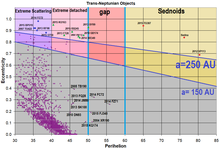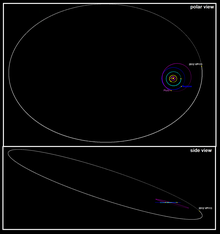2012 VP 113
|
Asteroid 2012 VP 113 |
|
|---|---|

|
|
| Properties of the orbit ( animation ) | |
| Orbit type | ETNO ( Sednoid ) SDO , "Distant Object" |
| Major semi-axis | 257.671 AU |
| eccentricity | 0.688 |
| Perihelion - aphelion | 80.424 AU - 434.917 AU |
| Inclination of the orbit plane | 24.1 ° |
| Length of the ascending node | 90.7 ° |
| Argument of the periapsis | 293.6 ° |
| Time of passage of the perihelion | June 8, 1978 |
| Sidereal period | approx. 4136 a |
| Mean orbital velocity | 1.840 km / s |
| Physical Properties | |
| Medium diameter | 574 km |
| Albedo | 0.09-0.15 |
| Absolute brightness | 4.0 - 4.5 mag |
| Spectral class | BV = 0.92 V-R = 0.52 |
| history | |
| Explorer |
Chadwick A. Trujillo Scott S. Sheppard |
| Date of discovery | 5th November 2012 |
| Another name | "Biden" |
| Source: Unless otherwise stated, the data comes from JPL Small-Body Database Browser . The affiliation to an asteroid family is automatically determined from the AstDyS-2 database . Please also note the note on asteroid items. | |
2012 VP 113 is a trans-Neptunian object with a diameter of about 450 kilometers and a distance of 80.5 astronomical units (AU) to 435 AU from the sun . The asteroid is a possible candidate for categorization as a dwarf planet because of its size . With 80.5 AU, it has the greatest perihelion distance of all known objects in the solar system before Sedna (76 AU) . Based on the orbits of Sedna and 2012 VP 113, astronomers and astrophysicists suspect that there are numerous other dwarf planets beyond these orbits on the edge of the solar system in the Kuiper Belt and the "inner" Oort cloud , and that the existence of a ninth planet is possible.
Discovery and naming
2012 VP 113 was on November 5, 2012 by astronomers Chad Trujillo and Scott Sheppard with the NOAO - telescopes of the Cerro Tololo Inter-American Observatory in Chile observed. The discovery was announced on March 26, 2014.
Since the "VP" in the preliminary designation in the USA corresponds to the abbreviation for Vice President , the asteroid was nicknamed Biden by the discovery team after the then Vice President of the USA, Joe Biden . Such a name does not correspond to the regulations of the IAU , so that an ultimately officially assigned name might be different.
After its discovery, VP 113 could be identified in 2012 on photos taken at the Mauna Kea Observatory on October 22, 2011, and thus its orbit calculated more precisely. So far in 2012, VP 113 has been observed with earth-based telescopes such as the Cerro Tololo and Las Campanas observatories . In April 2017, a total of 28 observations were made over a period of 6 years. The last observation so far was made in November 2016 at the Las Campanas Observatory. (As of March 8, 2019)
properties

Orbit
2012 VP 113 orbits the sun in 4136.24 years on a highly elliptical orbit between 80.42 AU and 434.92 AU from its center. The orbital eccentricity is 0.688, the orbit is inclined 24.11 ° to the ecliptic . It is currently (March 2019) 83.8 AU from the Sun. The last perihelion was in 1978; the next would have to happen around the year 6114.
Both Marc Buie ( DES ) and the Minor Planet Center classify the planetoid as SDO ; the latter also generally lists it as a "distant object" . The Johnston's Archives specifically lists it as a Sednoid .
size
It is currently assumed to be around 571 km in diameter; this value is based on an assumed reflectivity of 9% and an absolute brightness of 4.5 m . It can therefore be assumed that 2012 VP 113 is in hydrostatic equilibrium and the asteroid is therefore a dwarf planet candidate , based on Mike Brown's taxonomic 5-class system , from which this assessment comes. Brown assumes that 2012 VP 113 is likely a dwarf planet. The apparent magnitude of 2012 VP 113 is 23.44 m .
| year | Dimensions km | source |
|---|---|---|
| 2013 | 650.0 ± 350.0 | Trujillo et al. a. |
| 2014 | 650.0 ± 350.0 | Lakdawalla |
| 2018 | 702.0 | Johnston |
| 2018 | 574.0 | Brown |
| The most precise determination is marked in bold . | ||
| object |
Orbital period T (years) |
Semi-axis a (AE) |
Perihelion q (AE) |
Aphelion Q (AE) |
eccentricity e |
Argument of the periapsis ? (°) |
Inclination i (°) |
Length of the rise Node Ω (°) |
Perihelion π = ω + Ω (°) |
Absolute brightness H (mag) |
|---|---|---|---|---|---|---|---|---|---|---|
| (90377) Sedna | 10,590 | 482.24 | 76.08 | 888.39 | 0.84 | 311.6 | 11.9 | 144.4 | 96.0 | 1.5 |
| (474640) 2004 VN 112 | 5,602 | 315.41 | 47.31 | 583.51 | 0.85 | 326.9 | 25.6 | 66.0 | 32.9 | 6.5 |
| (523622) 2007 TG 422 | 10.165 | 469.26 | 35.55 | 902.96 | 0.92 | 285.6 | 18.6 | 112.9 | 38.5 | 6.5 |
| 2010 GB 174 | 6,824 | 359.75 | 48.79 | 670.72 | 0.86 | 347.7 | 21.6 | 130.8 | 118.5 | 6.5 |
| 2012 VP 113 ("Biden") | 4.106 | 256.40 | 80.44 | 432.37 | 0.69 | 293.6 | 24.1 | 90.7 | 24.3 | 4.0 |
| 2013 FT 28 | 5,558 | 313.77 | 43.52 | 584.02 | 0.86 | 40.3 | 17.3 | 217.8 | 258.1 | 6.7 |
| 2013 RF 98 | 6,556 | 350.30 | 36.08 | 664.52 | 0.90 | 311.7 | 29.6 | 67.6 | 19.3 | 8.7 |
| 2013 SY 99 ("uo3l91") | 17,604 | 676.71 | 49.96 | 1,303.45 | 0.93 | 32.3 | 4.2 | 29.5 | 61.8 | 6.7 |
| 2014 FE 72 | 101.195 | 2,171.57 | 36.28 | 4,306.86 | 0.98 | 134.3 | 20.6 | 336.8 | 111.1 | 6.1 |
| 2014 SR 349 | 5,064 | 294.90 | 47.65 | 542.14 | 0.84 | 341.1 | 18.0 | 34.8 | 15.9 | 6.7 |
| 2015 GT 50 ("o5p060") | 6,073 | 332.85 | 38.46 | 627.24 | 0.88 | 129.3 | 8.8 | 46.1 | 175.4 | 8.5 |
| 2015 KG 163 ("o5m52") | 23,718 | 825.50 | 40.50 | 1,610.50 | 0.95 | 32.0 | 14.0 | 219.1 | 251.1 | 8.2 |
| 2015 RX 245 ("o5t52") | 8,210 | 406.96 | 45.52 | 768.40 | 0.89 | 65.3 | 12.2 | 8.6 | 73.9 | 6.2 |
| 2015 BP 519 ("Caju") | 8,932 | 430.48 | 35.14 | 825.81 | 0.92 | 348.4 | 54.1 | 135.2 | 123.6 | 4.4 |
| (541132) Leleākūhonua | 36,182 | 1,093.94 | 64.94 | 2,122.94 | 0.94 | 118.2 | 11.6 | 300.8 | 59.0 | 5.3 |
See also
- List of asteroids
- List of moons from asteroids
- List of trans-Neptunian objects
- List of dwarf planets of the solar system
literature
- Michael E. Brown, Chadwick A. Trujillo, David L. Rabinowitz: Discovery of a Candidate Inner Oort Cloud Planetoid. In: The Astrophysical Journal , Volume 617, Number 1, 2004, pp. 645-649, doi: 10.1086 / 422095 .
- Megan E. Schwamb et al .: of the distant Kuiper belt: results from the Palomar Distant Solar System Survey. In: The Astrophysical Journal , Volume 720, Number 2, 2010, pp. 1691-1707, doi: 10.1088 / 0004-637X / 720/2/1691 .
- Chadwick A. Trujillo, Scott S. Sheppard: A Sedna-like body with a perihelion of 80 astronomical units. In: Nature , Volume 507, Number 7493, March 27, 2014, pp. 471-474, doi: 10.1038 / nature13156 .
Web links
- Robert Czepel: Dwarf Planet: Stranded in No Man's Land , science.ORF.at, March 27, 2014, accessed on April 30, 2014.
- without author: Faraway dwarf planet: researchers discover outsiders in the solar system . In: SpiegelOnline Wissenschaft , March 27, 2014, accessed April 30, 2014.
- Pictures of the discovery by Scott Sheppard / Carnegie Institution for Science (English)
Individual evidence
- ↑ a b c Wm. R. Johnston: List of Known Trans-Neptunian Objects . Johnston's Archives. October 7, 2018. Retrieved March 8, 2019.
- ^ A b Marc W. Buie : Orbit Fit and Astrometric record for 12VP113 . SwRI (Space Science Department). Retrieved March 8, 2019.
- ↑ a b MPC : MPEC List Of Centaurs and Scattered-Disk Objects . IAU . Retrieved March 8, 2019.
- ↑ a b c 2012 VP113 at the IAU Minor Planet Center (English). Accessed March 8, 2019.
- ↑ v ≈ π * a / period (1 + sqrt (1-e²))
- ↑ Tobias Jobke: References to “planet giants” on the edge of our solar system. In: WDR5. Leonardo - Wissenschaft und mehr , March 27, 2014, online ( memento of the original from March 29, 2014 in the Internet Archive ) Info: The archive link was inserted automatically and has not yet been checked. Please check the original and archive link according to the instructions and then remove this notice. , accessed April 30, 2014.
- ↑ Alexandra Jokes: Dwarf planet stretches Solar System's edge. In: Nature online , March 26, 2014, online , accessed April 30, 2014.
- ↑ Amina Khan: New dwarf planet in the Oort cloud changes picture of solar system. In: Los Angeles Times Science , March 26, 2014, online , accessed April 30, 2014.
- ↑ MPC : MPEC 2014-F40: 2012 VP113 . IAU . July 17, 2016. Retrieved March 8, 2019.
- ↑ Christoph Behrens: Researchers find evidence of unknown super-earth. In: Süddeutsche.de , March 27, 2014, online , accessed April 30, 2014
- ↑ Amina Khan: Dwarf planet 2012 VP-113 found in far reaches of the solar system. In: The Sydney Morning Herald Technology , March 27, 2014, online , accessed April 30, 2014.
- ^ Naming of Astronomical Objects. International Astronomical Union, accessed on April 30, 2014 (English): "The names of individuals or events principally known for political or military activities are unsuitable until 100 years after the death of the individual or the occurrence of the event."
- ↑ Russell Westerholm: Joe Biden Was Inspiration for New Dwarf Planet 2012 VP 113, But the Name Probably Won't Stick. In: UniversityHerald , March 27, 2014, online , accessed April 30, 2014
- ↑ 2012 VP113 in the Small-Body Database of the Jet Propulsion Laboratory (English). Retrieved March 8, 2019.
- ^ Tilmann Althaus: Small planet Sedna is not alone. In: Spektrum.de , March 28, 2014, online , accessed April 30, 2014.
- ↑ 2012 VP113 in the database of the "Asteroids - Dynamic Site" (AstDyS-2, English).
- ↑ C. Trujillo et al. a .: A Sedna-like body with a perihelion of 80 astronomical units (PDF, October 2013).
- ↑ E. Lakdawalla: A second Sedna! What does it mean? (March 2014).
- ↑ Mike Brown : How many dwarf planets are there in the outer solar system? . CalTech . November 12, 2018. Retrieved March 8, 2019.
- ↑ Website of the Minor Planet Center (MPC), list of objects with q> 30 and a> 250. International Astronomical Union (IAU), accessed January 19, 2020 .
